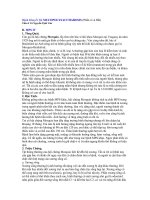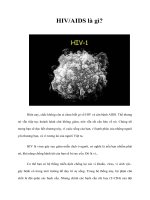Tài liệu Informatics in Medical Imaging pdf
Bạn đang xem bản rút gọn của tài liệu. Xem và tải ngay bản đầy đủ của tài liệu tại đây (5.19 MB, 352 trang )
Informatics in Medical Imaging
Kagadis
Langer
Informatics in
Medical Imaging
Radiology / Medical Imaging
Edited by
George C. Kagadis and Steve Langer
K11526
ISBN: 978-1-4398-3124-3
9 781439 831243
90000
Informatics in Medical Imaging provides a comprehensive survey of the field of medical imaging
informatics. In addition to radiology, it also addresses other specialties such as pathology, cardiology,
dermatology, and surgery, that have adopted the use of digital images. The book discusses basic imaging
informatics protocols, picture archiving and communication systems, and the electronic medical record. It
details key instrumentation and data mining technologies used in medical imaging informatics as well as
practical operational issues, such as procurement, maintenance, teleradiology, and ethics.
Highlights
• Introduces the basic ideas of imaging informatics, the terms used, and how data are represented
and transmitted
• Emphasizes the fundamental communication paradigms: HL7, DICOM, and IHE
• Describes information systems that are typically used within imaging departments: orders and
results systems, acquisition systems, reporting systems, archives, and information-display systems
• Outlines the principal components of modern computing, networks, and storage systems
• Covers the technology and principles of display and acquisition detectors, and rounds out with a
discussion of other key computer technologies
• Discusses procurement and maintenance issues, ethics and its relationship to government initiatives
like HIPAA, and constructs beyond radiology
The technologies of medical imaging and radiation therapy are so complex and computer-driven
that it is difficult for physicians and technologists responsible for their clinical use to know exactly
what is happening at the point of care. Medical physicists are best equipped to understand the
technologies and their applications, and these individuals are assuming greater responsibilities in
the clinical arena to ensure that intended care is delivered in a safe and effective manner. Built on
a foundation of classic and cutting-edge research, Informatics in Medical Imaging supports
and updates medical physicists functioning at the intersection of radiology and radiation oncology.
K11526_COVER_final.indd 1 9/8/11 5:42 PM
Informatics in
Medical Imaging
IMAGING IN MEDICAL DIAGNOSIS AND THERAPY
William R. Hendee, Series Editor
Quality and Safety in Radiotherapy
Todd Pawlicki, Peter B. Dunscombe, Arno J. Mundt, and
Pierre Scalliet, Editors
ISBN: 978-1-4398-0436-0
Adaptive Radiation Therapy
X. Allen Li, Editor
ISBN: 978-1-4398-1634-9
Forthcoming titles in the series
Image-Guided Radiation Therapy
Daniel J. Bourland, Editor
ISBN: 978-1-4398-0273-1
Informatics in Radiation Oncology
Bruce H. Curran and George Starkschall, Editors
ISBN: 978-1-4398-2582-2
Adaptive Motion Compensation in Radiotherapy
Martin Murphy, Editor
ISBN: 978-1-4398-2193-0
Image Processing in Radiation Therapy
Kristy Kay Brock, Editor
ISBN: 978-1-4398-3017-8
Proton and Carbon Ion Therapy
Charlie C M. Ma and Tony Lomax, Editors
ISBN: 978-1-4398-1607-3
Monte Carlo Techniques in Radiation Therapy
Jeffrey V. Siebers, Iwan Kawrakow, and
David W. O. Rogers, Editors
ISBN: 978-1-4398-1875-6
Quantitative MRI in Cancer
Thomas E. Yankeelov, David R. Pickens, and
Ronald R. Price, Editors
ISBN: 978-1-4398-2057-5
Informatics in Medical Imaging
George C. Kagadis and Steve G. Langer, Editors
ISBN: 978-1-4398-3124-3
Informatics in Medical Imaging
George C. Kagadis and Steve G. Langer, Editors
ISBN: 978-1-4398-3124-3
Stereotactic Radiosurgery and Radiotherapy
Stanley H. Benedict, Brian D. Kavanagh, and
David J. Schlesinger, Editors
ISBN: 978-1-4398-4197-6
Cone Beam Computed Tomography
Chris C. Shaw, Editor
ISBN: 978-1-4398-4626-1
Handbook of Brachytherapy
Jack Venselaar, Dimos Baltas, Peter J. Hoskin, and
Ali Soleimani-Meigooni, Editors
ISBN: 978-1-4398-4498-4
Targeted Molecular Imaging
Michael J. Welch and William C. Eckelman, Editors
ISBN: 978-1-4398-4195-0
Informatics in
Medical Imaging
ImagIng In medIcal dIagnosIs and Therapy
William R. Hendee, Series Editor
Edited by
George C. Kagadis
Steve G. Langer
A TAY L O R & FR A N C IS B O O K
CRC Press is an imprint of the
Taylor & Francis Group, an informa business
Boca Raton London New York
CRC Press
Taylor & Francis Group
6000 Broken Sound Parkway NW, Suite 300
Boca Raton, FL 33487-2742
© 2012 by Taylor & Francis Group, LLC
CRC Press is an imprint of Taylor & Francis Group, an Informa business
No claim to original U.S. Government works
Version Date: 2011909
International Standard Book Number-13: 978-1-4398-3136-6 (eBook - PDF)
This book contains information obtained from authentic and highly regarded sources. Reasonable efforts have been made to publish reliable data and
information, but the author and publisher cannot assume responsibility for the validity of all materials or the consequences of their use. The authors and
publishers have attempted to trace the copyright holders of all material reproduced in this publication and apologize to copyright holders if permission
to publish in this form has not been obtained. If any copyright material has not been acknowledged please write and let us know so we may rectify in any
future reprint.
Except as permitted under U.S. Copyright Law, no part of this book may be reprinted, reproduced, transmitted, or utilized in any form by any electronic,
mechanical, or other means, now known or hereafter invented, including photocopying, microfilming, and recording, or in any information storage or
retrieval system, without written permission from the publishers.
For permission to photocopy or use material electronically from this work, please access www.copyright.com ( or contact
the Copyright Clearance Center, Inc. (CCC), 222 Rosewood Drive, Danvers, MA 01923, 978-750-8400. CCC is a not-for-profit organization that provides
licenses and registration for a variety of users. For organizations that have been granted a photocopy license by the CCC, a separate system of payment
has been arranged.
Trademark Notice: Product or corporate names may be trademarks or registered trademarks, and are used only for identification and explanation
without intent to infringe.
Visit the Taylor & Francis Web site at
and the CRC Press Web site at
To my son Orestis who has blessed me with love, continuously challenging me
to become a better person, and my wife Voula who stands by me every day.
To George Nikiforidis and Bill Hendee for their continuous support and dear friendship.
George C. Kagadis
Of course I want to thank my mother (Betty Langer) and wife Sheryl for their support,
butinadditionIwouldlike to dedicate this eort to my mentors . . .
My father Calvin Lloyd Langer, whose endless patience for a questioning youngster
set a good example.
My graduate advisor Dr. Aaron Galonsky, who trusted a green graduate student
in his lab and kindly steered him to a growing branch of physics.
My residency advisor, Dr. Joel Gray, who taught science ethics before that phrase became an oxymoron.
And to my precious Gabi, if her father can set half the example of his mentors, she will do well.
Steve G. Langer
This page intentionally left blankThis page intentionally left blank
vii
Contents
Series Preface ix
Preface xi
Editors
xiii
Contributors
xv
SECTION I Introduction to Informatics in Healthcare
1 Ontologies in the Radiology Department 3
Dirk Marwede
2 Informatics Constructs 15
Steve G. Langer
SECTION II Standard Protocols in Imaging Informatics
3 Health Level 7 Imaging Integration 27
Helmut König
4 DICOM 41
Steven C. Horii
5 Integrating the Healthcare Enterprise IHE 69
Steve G. Langer
SECTION III Key Technologies
6 Operating Systems 85
Christos Alexakos and George C. Kagadis
7 Networks and Networking 99
Christos Alexakos and George C. Kagadis
8 Storage and Image Compression 115
Craig Morioka, Frank Meng, and Ioannis Sechopoulos
9 Displays 135
Elizabeth A. Krupinski
10 Digital X-Ray Acquisition Technologies 145
John Yorkston and Randy Luhta
viii Contents
11 Efficient Database Designing 163
John Drakos
12 Web-Delivered Interactive Applications 173
John Drakos
13 Principles of Three-Dimensional Imaging from Cone-Beam Projection Data 181
Frédéric Noo
14 Multimodality Imaging 199
Katia Passera, Anna Caroli, and Luca Antiga
15 Computer-Aided Detection and Diagnosis 219
Lionel T. Cheng, Daniel J. Blezek, and Bradley J. Erickson
SECTION IV Information Systems in Healthcare Informatics
16 Picture Archiving and Communication Systems 235
Brent K. Stewart
17 Hospital Information Systems, Radiology Information Systems, and
Electronic Medical Records 251
Herman Oosterwijk
SECTION V Operational Issues
18 Procurement 267
Boris Zavalkovskiy
19 Operational Issues 275
Shawn Kinzel, Steve G. Langer, Scott Stekel, and Alisa Walz-Flannigan
20 Teleradiology 289
Dimitris Karnabatidis and Konstantinos Katsanos
21 Ethics in the RadiologyDepartment 297
William R. Hendee
SECTION VI Medical Informatics beyond the Radiology Department
22 Imaging Informatics beyond Radiology 311
Konstantinos Katsanos, Dimitris Karnabatidis, George C. Kagadis, George C. Sakellaropoulos,
and George C. Nikiforidis
23 Informatics in Radiation Oncology 325
George Starkschall and Peter Balter
Index 333
ix
Series Preface
Advances in the science and technology of medical imaging and radiation therapy are more profound and rapid than ever before,
since their inception over a century ago. Further, the disciplines are increasingly cross-linked as imaging methods become more
widely used to plan, guide, monitor, and assess the treatments in radiation therapy. Today, the technologies of medical imaging and
radiation therapy are so complex and so computer-driven that it is dicult for the persons (physicians and technologists) respon-
sible for their clinical use to know exactly what is happening at the point of care, when a patient is being examined or treated.
e persons best equipped to understand the technologies and their applications are medical physicists, and these individuals are
assuming greater responsibilities in the clinical arena to ensure that what is intended for the patient is actually delivered in a safe
and eective manner.
e growing responsibilities of medical physicists in the clinical arenas of medical imaging and radiation therapy are not with-
out their challenges, however. Most medical physicists are knowledgeable in either radiation therapy or medical imaging, and are
experts in one or a small number of areas within their discipline. ey sustain their expertise in these areas by reading scientic
articles and attending scientic talks at meetings. In contrast, their responsibilities increasingly extend beyond their specic areas
of expertise. To meet these responsibilities, medical physicists periodically must refresh their knowledge of advances in medical
imaging or radiation therapy, and they must be prepared to function at the intersection of these two elds. How to accomplish these
objectives is a challenge.
At the 2007 annual meeting of the American Association of Physicists in Medicine in Minneapolis, this challenge was the topic
of conversation during a lunch hosted by Taylor & Francis Publishers and involving a group of senior medical physicists (Arthur L.
Boyer, Joseph O. Deasy, C M. Charlie Ma, Todd A. Pawlicki, Ervin B. Podgorsak, Elke Reitzel, Anthony B. Wolbarst, and Ellen D.
Yorke). e conclusion of this discussion was that a book series should be launched under the Taylor & Francis banner, with each
volume in the series addressing a rapidly advancing area of medical imaging or radiation therapy of importance to medical physi-
cists. e aim would be for each volume to provide medical physicists with the information needed to understand the technologies
driving a rapid advance and their applications to safe and eective delivery of patient care.
Each volume in the series is edited by one or more individuals with recognized expertise in the technological area encompassed by
the book. e editors are responsible for selecting the authors of individual chapters and ensuring that the chapters are comprehensive
and intelligible to someone without such expertise. e enthusiasm of volume editors and chapter authors has been gratifying and
reinforces the conclusion of the Minneapolis luncheon that this series of books addresses a major need of medical physicists.
Imaging in Medical Diagnosis and erapy would not have been possible without the encouragement and support of the series
manager, Luna Han of Taylor & Francis Publishers. e editors and authors, and most of all I, are indebted to her steady guidance
of the entire project.
William R. Hendee
Series Editor
Rochester, Minnesota
This page intentionally left blankThis page intentionally left blank
xi
Preface
e process of collecting and analyzing the data is critical in healthcare as it constitutes the basis for categorization of patient health
problems. Data collected in medical practice ranges from free form text to structured text, numerical measurements, recorded
signals, and imaging data. When admitted to the hospital, the patient oen experiences additional tests varying from simple exami-
nations such as blood tests, x-rays and electrocardiograms (ECGs), to more complex ones such as genetic tests, electromyograms
(EMGs), computed tomography (CT), magnetic resonance imaging (MRI), and position emission tomography (PET). Historically,
the demographics collected from all these tests were characterized by uncertainty because oen there was not a single authorita-
tive source for patient demographic information, and multiple points of human-entered data were not all in perfect agreement. e
results from these tests are then archived in databases and subsequently retrieved (or not—if the “correct” demographic has been
forgotten) upon requests by clinicians for patient management and analysis.
For these reasons, digital medical databases and, consequently, the Electronic Health Record (EHR) have emerged in healthcare.
Today, these databases have the advantage of high computing power and almost innite archiving capacity as well as Web avail-
ability. Access through the Internet has provided the potential for concurrent data sharing and relevant backup. is procedure of
appropriate data acquisition, archiving, sharing, retrieval, and data mining is the focus of medical informatics. All this information
is deemed vital for ecient provision of healthcare (Kagadis etal., 2008).
Medical imaging informatics is an important subcomponent of medical informatics and deals with aspects of image generation,
manipulation, management, integration, storage, transmission, distribution, visualization, and security (Huang, 2005; Shortlie
and
Cim
ino, 2006). Medical imaging informatics has advanced rapidly, and it is no surprise that it has evolved principally in radiol-
ogy, the home of most imaging modalities. However, many other specialties (i.e., pathology, cardiology, dermatology, and surgery)
have adopted the use of digital images; thus, imaging informatics is used extensively in these specialties as well.
Owing to continuous progress in image acquisition, archiving, and processing systems, the eld of medical imaging informatics
continues to rapidly change and there are many books written every year to reect this evolution. While much reference material
is available from the American Association of Physicists in Medicine (AAPM), the Society for Imaging Informatics in Medicine
(SIIM) Task Group reports, European guidance documents, and the published literature, this book tries to ll a gap and provide an
integrated publication dealing with the most essential and timely issues within the scope of informatics in medical imaging.
e target audience for this book is students, researchers, and professionals in medical physics and biomedical imaging with an
interest in informatics. It may also be used as a reference guide for medical physicists and radiologists needing information on infor-
matics in medical imaging. It provides a knowledge foundation of the state of the art in medical imaging informatics and points to
major challenges of the future.
e book content is grouped into six sections. Section I deals with introductory material to informatics as it pertains to healthcare.
Section II deals with the standard imaging informatics protocols, while Section III covers healthcare informatics based enabling
technologies. In Section IV, key systems of radiology informatics are discussed and in Section V special focus is given to operational
issues in medical imaging. Finally, Section VI looks at medical informatics issues outside the radiology department.
References
Huang, H.K. 2005. Medical imaging informatics research and development trends. Comput. Med. Imag. Graph., 29, 91–3.
Kagadis, G.C., Nagy, P., Langer, S., Flynn, M., Starkschall, G. 2008. Anniversary paper:
Roles
of medical physicists and healthcare
ap
plications of informatics. Med. Phys., 35, 119–27.
Shortlie, E.H., Cimino, J.J. 2006. Biomedical Informatics: Computer Applications in Healthcare and Biomedicine (Health Informatics).
New York, NY: Springer.
George C. Kagadis
Steve G. Langer
Editors
This page intentionally left blankThis page intentionally left blank
xiii
Editors
George C. Kagadis, PhD is currently an assistant professor of medical physics and medical
informatics at University of Patras, Greece. He received his Diploma in Physics from the
University of Athens, Greece in 1996 and both his MSc and PhD in medical physics from the
University of Patras, Greece in 1998 and 2002, respectively. He is a Greek State Scholarship
Foundation grantee, a Fulbright Research Scholar, and a full AAPM member. He has authored
approximately 70 journal papers and had presented over 20 talks at international meetings.
Dr. Kagadis has been involved in European and national projects, including e-health. His cur-
rent research interests focus on IHE, CAD applications, medical image processing and analysis
as well as studies in molecular imaging. Currently, he is a member of the AAPM Molecular
Imaging in Radiation Oncology Work Group, European Aairs Subcommittee, Work Group on
Information Technology, and an associate editor to Medical Physics.
Steve G. Langer, PhD is currently a codirector of the radiology imaging informatics lab at the
Mayo Clinic in Rochester, Minnesota and formerly served on the faculty of the University of
Washington, Seattle. His formal training in nuclear physics at the University of Wisconsin,
Madison and Michigan State has given way to a new mission: to design, enable, and guide into
production high-performance computing solutions to implement next-generation imaging
informatics analytics into the clinical practice. is includes algorithm design, validation, per-
formance proling, and deployment on vended or custom platforms as required. He also has
extensive interests in validating the behavior and performance of human- and machine-based
(CAD) diagnostic agents.
This page intentionally left blankThis page intentionally left blank
xv
Contributors
Christos Alexakos
Department of Computer
Engineeringand Informatics
University of Patras
Rion, Greece
Luca Antiga
Biomedical Engineering Department
Mario Negri Institute
Bergamo, Italy
Peter Balter
Department of Radiation Physics
e University of Texas
Houston, Texas
Daniel J. Blezek
Department of Bioengineering
Mayo Clinic
Rochester, Minnesota
Anna Caroli
Biomedical Engineering Department
Mario Negri Institute
Bergamo, Italy
and
Laboratory of Epidemiology,
Neuroimaging,
andTelemedicine
IRCCS San Giovanni di Dio-FBF
Brescia, Italy
Lionel T. Cheng
Singapore Armed Forces
MedicalCorps
and
Singapore General Hospital
Singapore
John Drakos
Clinic of Haematology
University of Patras
Rion, Greece
Brad J. Erickson
Department of Radiology
Mayo Clinic
Rochester, Minnesota
William R. Hendee
Departments of Radiology, Radiation
Oncology, Biophysics, and
Population Health
Medical College of Wisconsin
Milwaukee, Wisconsin
Steven C. Horii
Department of Radiology
University of Pennsylvania Medical
Center
Philadelphia, Pennsylvania
George C. Kagadis
Department of Medical Physics
University of Patras
Rion, Greece
Dimitris Karnabatidis
Department of Radiology
Patras University Hospital
Patras, Greece
Konstantinos Katsanos
Department of Radiology
Patras University Hospital
Patras, Greece
Shawn Kinzel
Information Systems
Mayo Clinic
Rochester, Minnesota
Helmut König
Siemens AG Healthcare Sector
Erlangen, Germany
Elizabeth A. Krupinski
Department of Radiology
University of Arizona
Tucson, Arizona
Steve G. Langer
Department of Diagnostic Radiology
Mayo Clinic
Rochester, Minnesota
Randy Luhta
CT Engineering
Philips Medical Systems
Cleveland, Ohio
Dirk Marwede
Department of Nuclear Medicine
University of Leipzig
Leipzig, Germany
Frank Meng
VA Greater Los Angles Healthcare
System
Los Angeles, California
Craig Morioka
UCLA Medical Imaging Informatics
and
VA Greater Los Angles Healthcare
System
Los Angeles, California
George C. Nikiforidis
Department of Medical Physics
University of Patras
Patras, Greece
Frédéric Noo
Department of Radiology
University of Utah
Salt Lake City, Utah
xvi Contributors
Herman Oosterwijk
OTech Inc.
Cross Roads, Texas
Katia Passera
Biomedical Engineering Department
Mario Negri Institute
Bergamo, Italy
George C. Sakellaropoulos
Department of Medical Physics
University of Patras
Patras, Greece
Ioannis Sechopoulos
Department of Radiology, Hematology,
and MedicalOncology
Emory University
Atlanta, Georgia
George Starkschall
Department of Radiation Physics
e University of Texas
Houston, Texas
Scott Stekel
Department of Radiology
Mayo Clinic
Rochester, Minnesota
Brent K. Stewart
Department of Radiology
University of Washington School
ofMedicine
Seattle, Washington
Alisa Walz-Flannigan
Department of Radiology
Mayo Clinic
Rochester, Minnesota
John Yorkston
Carestream Health
Rochester, New York
Boris Zavalkovskiy
Enterprise Imaging
Lahey Clinic, Inc.
Burlington, Massachusetts
1
I
Introduction to
Informatics in
Healthcare
This page intentionally left blankThis page intentionally left blank
3
Ontologies have become increasingly popular to structure
knowledge and exchange information. In medicine, the main
areas for the application of ontologies are the encoding of
information with standardized terminologies and the use of
for
malized medical knowledge in expert systems for decision
support. In medical imaging, the ever-growing number of imag-
ing studies and digital data requires tools for comprehensive and
eective information management. Ontologies provide human-
and machine-readable information and bring the prospective of
semantic data integration. As such, ontologies might enhance
interoperability between systems and facilitate dierent tasks in
the radiology department like patient management, structured
reporting, decision support, and image retrieval.
1.1 Ontologies and Knowledge
Representation
ere have been many attempts to dene what an ontology
is. Originally, in the philosophical branch of metaphysics,
an ontology deals with questions concerning the existence of
entities in reality and how such entities relate to each other.
In information and computer science, an ontology has been
dened as a body of formally represented knowledge based on
a conceptualization. Such a conceptualization is an explicit
specication of objects, concepts, and other entities that are
assumed to exist in some area of interest and the relations
that hold among them (Genesereth and Nilsson, 1987; Gruber,
1993). Similarly, the term knowledge representation has been
used in articial intelligence, a branch of computer science, to
describe a formal system representing knowledge by a set of
rules that are used to infer (formalized reasoning) new knowl-
edge within a specic domain.
Besides dierent denitions, the term ontology nowadays
is oen used to describe dierent levels of usage. ese levels
include (1) the denition of a common vocabulary, (2) the stan-
dardization of terms, concepts, or tasks, (3) conceptual schemas
for transfer, reuse, and sharing of information, (4) organization
and representation of knowledge, and (5) answering questions or
queries. From those usages, some general benets of ontologies
in information management can be dened
• To enhance the interoperability between information
systems
• To transmit, reuse, and share the structured data
• To facilitate the data aggregation and analysis
• To integrate the knowledge (e.g., a model) and data (e.g.,
patient data)
1
Ontologies in the
Radiology Department
1.1 Ontologies and Knowledge Representation 3
1.2
Onto
logy Components
4
ConceptsandInstances • Relations • RestrictionsandInheritance
1.3 Ontology Construction 4
1.4
Rep
resentation Techniques
4
1.5
Typ
es of Ontologies
5
Upper-LevelOntologies • ReferenceOntologies • ApplicationOntologies
1.6 Ontologies in Medical Imaging 6
1.7
Fou
ndational Elements and Principles 7
TerminologiesinRadiology • Interoperability
1.8 Application Areas of Ontologies in Radiology 8
ImagingProcedureAppropriateness • ClinicalPracticeGuidelines • OrderEntry
1.9 Image Interpretation 9
StructuredReporting • DiagnosticDecisionSupportSystems • Results
Communication • SemanticImageRetrieval • TeachingCases,KnowledgeBases,
andE-Learning
References 12
Dirk Marwede
University of Leipzig
4 Informatics in Medical Imaging
1.2 Ontology Components
1.2.1 Concepts and Instances
e main component of ontologies are concepts also called
classes, entities, or elements. Concepts can be regarded as “unit
of thoughts,” that is, some conceptualization with a specic
meaning whereas the meaning of concepts can be implicitly or
explicitly dened. Concepts with implicit denitions are oen
called primitive concepts. In contrast, concepts with explicit
denitions (i.e., dened concepts) are dened by relations to
other concepts and sometimes restrictions (e.g., a value range).
Concepts or classes can have instances, that is, individuals, for
which all dened relations hold true. Concepts are components
of a knowledge model whereas instances populate this model
with individual data. For example, the concepts Patient Name
and Age can have instances such as John Doe and 37.
1.2.2 Relations
Relations are used to link concepts to each other or to attach
attributes to concepts. Binary relations are used to relate con-
cepts to each other. e hierarchical organization of concepts
in an ontology is usually based on the is_a (i.e., is a subtype
of) relation, which relates a parent concept to a child concept
(e.g., “inammation” is_a “disease”). e relation is also called
subsumption as the relation subsumes sub-concepts under a
super-concept. In the medical domain, many relations express
structural (e.g., anatomy), spatial (e.g., location and position),
functional (e.g., pathophysiological processes), or causative
information (e.g., disease cause). For example, structural infor-
mation can be described by partonomy relations like part_of
or has_part (e.g., “liver vein” part_of “liver”), spatial informa-
tion by the relation located_in (e.g., “cyst” located_in “liver”), or
contained_in (e.g., “thrombus” contained_in “lumen of pulmo-
nary artery”), and functional information by the relation regu-
lates (e.g., “apoptosis” regulates “cell death”). Attributes can be
attached to concepts by relations like has_shape or has_density
(e.g., “pulmonary nodule” has_shape “round”).
A relation can be dened by properties like transitivity,
sym
metry/antisymmetry, and reexivity (Smith and Rosse, 2004;
Smith etal., 2005). For example, a relation R over a class X is tran-
sitive if an element a is related to an element b, and b is in turn
related to an element c, then a is also related to c (e.g., “pneumo-
nia” is_a “inammation” is_a “disease” denotes that “pneumonia”
is_a “disease”). Relational properties are mathematical denitions
from set theory, which can be explicitly dened in some ontology
or representation languages (Baader etal., 2003; Levy, 2002).
1.2.3 Restrictions and Inheritance
Beside formal characteristics of relations, further logical state-
ments can be attached to concepts. Such logical expressions
are called restrictions or axioms, which explicitly dene con-
cepts. Basic restrictions include domain and range restrictions
that dene which concepts can be linked through a relation.
Restrictions can be applied to the ller of a relation, for exam-
ple, to a value, concept, or concept type and depend on the
representation formalism used. In general, restrictions are com-
monly deployed in large ontologies to support reasoning tasks
for checking consistency of the ontology (Baader et al., 2003;
Rector etal., 1997). Inheritance is a mechanism deployed in most
ontologies in which a child concept inherits all denitions of the
parent concept. Some ontology languages support mechanism
of multiple inheritance in which a child concept inherits deni-
tions of dierent parent concepts.
1.3 Ontology Construction
e construction of an ontology usually starts with a specica-
tion to dene the purpose and scope of an ontology. In a second
step, concepts and relations in a domain are identied (concep-
tualization) oen involving natural language processing (NLP)
algorithms and domain experts. Aerwards, the description of
concepts is transformed in a formal model by the use of restric-
tions (
for
malization) followed by the implementation of the
ontology in a representation language. Finally, maintenance of
the implemented ontology is achieved by testing, updating, and
correcting the ontology. Many ontologies today, in particular
controlled terminologies or basic symbolic knowledge mod-
els, do not support formalized reasoning. In fact, even if not all
ontologies require reasoning support to execute specic tasks,
reasoning techniques are useful during ontology construction
to check consistency of the evolving ontology.
In most ontologies, concepts are precoordinated which means
that primitive or dened concepts cannot be modied. However,
in particular within large domains like medicine, some ontol-
ogies support postcoordination of concepts which allows
to construct new concepts by the combination of
primitive
or dened concepts by the user (Rector and Nowlan, 1994).
Postcoordination requires strict rules for concept denition to
assure semantic and logical consistency within an ontology.
1.4 Representation Techniques
e expressivity of ontology languages to represent knowledge
ranges from informal approaches with little or no specication
of the meaning of terms to formal languages with strict logical
denitions (Staab and Studer, 2009). In general, there is a trade-
o between logical expressivity of languages and computational
eciency, thus the appropriate ontology language or representa-
tion formalism needs to be chosen with regard to the domain of
interest and the intent of the ontology.
First knowledge representation languages include semantic
networks and frame-based approaches. Semantic networks rep-
resent semantic relations among concepts in a graph structure
(Sowa, 1987). Within such networks, it is possible to represent
logical description, for example existential graphs or conceptual
graphs. Frame-based systems use a frame to represent an entity
within a domain (Minsky, 1975). Frames are associated with a
5Ontologies in the Radiology Department
number of slots that can be lled with slot values that are also
frames. Protégé is a popular open-source ontology editor using
frames, which is compatible to the open knowledge base con-
nectivity protocol (OKBC) (Noy etal., 2003).
Description logics (DLs) are a family of representation lan-
guages using formal descriptions for concept denitions. In
contrast to semantic networks and frame-based models, DLs
use formal, logic-based semantics for knowledge representa-
tion. In addition to the description formalism, DLs are usually
composed of two components—a terminological formalism
describing names for complex descriptions (T-Box) and a asser-
tional formalism used to state properties for individuals (A-Box)
(Baader etal., 2009).
e resource description framework (RDF) is a framework
for representing information about resources in a graph form.
e Web Ontology Language (OWL), an extension of RDF, is
a language for semantic representation of Web content. OWL
adds more vocabulary for describing properties and classes, that
is, relations between classes (e.g., disjointness), cardinality (e.g.,
“exactly one”), equality, richer typing of properties, character-
istics of properties (e.g., symmetry), and enumerated classes.*
OWL provides three sublanguages with increasing expressivity
and reasoning power: OWL Lite supports users primarily con-
cerned with classication hierarchies and simple constraints,
OWL DL provides maximum expressiveness while retaining
computational completeness, and OWL Full has maximum
expressiveness and the syntactic freedom of RDF with no com-
putational guarantees. Today, some frame-based ontology edi-
tors provide plug-ins for OWL support combining frame-based
*
/>knowledge models with logical expressivity and reasoning
capacities (Figure 1.1).
1.5 Types of Ontologies
Medicine is a very knowledge intensive area with a long tradi-
tion in structuring its information. First attempts focussed on
the codication of medical terminology resulting in hierarchi-
cal organized controlled vocabularies and terminologies, for
example, the International Classication of Disease (ICD). e
introduction of basic relations between entries in dierent hier-
archies resulted in more complex medical terminologies like the
Systematized Nomenclature of Medicine (Snomed) (Spackman
et al., 1997). However, in recent years, complex knowledge
models with or without formal reasoning support have been
constructed like the Foundational Model of Anatomy (FMA)
(Rosse and Mejino, 2003) or the Generalized Architecture for
Languages, Encyclopaedias, and Nomenclatures in Medicine
(GALEN) (Rector and Nowlan, 1994).
1.5.1 Upper-Level Ontologies
A top- or upper-level ontology is a domain-independent repr-
ese
ntation of very basic concepts and relations (objects, space,
time). In information and computer science, the main aim of
such an ontology is to facilitate the integration and interoper-
ability of domain-specic ontologies. Building a comprehensive
upper-level ontology is a complex task and dierent upper-level
ontologies have been developed with considerable dierences
in scope, syntax, semantics, and representational formalisms
(Grenon and Smith, 2004; Herre etal., 2006; Masolo etal., 2003).
FIGURE 1.1 Denition of concepts in a frame-based ontology editor with OWL support (Protégé OWL).
6 Informatics in Medical Imaging
Today, the use of a single upper-level ontology subsuming con-
cepts and relations of all domain-specic ontologies is questioned
and probably not desirable in terms of computational feasibility.
1.5.2 Reference Ontologies
In large domains like medicine, many concepts and relations
are foundational in the sense that ontologies within the same or
related domain use or refer to those concepts and relations. is
observation has led to the notion of Foundational or Reference
Ontologies that serve as a basis or reference for other ontologies
(Burgun, 2006). e most-known reference ontology in medicine
is the Foundational Model of Anatomy (FMA), a comprehensive
ontology of structural human anatomy, consisting of over 70,000
dierent concepts and 170 relationships with approximately 1.5
million instantiations (Rosse and Mejino, 2003) (Figure 1.2). An
important characteristic of reference ontologies is that they are
developed independently of any particular purpose and should
reect the underlying reality (Bodenreider and Burgun, 2005).
1.5.3 Application Ontologies
Application ontologies are constructed with a specic context
and target group in mind. In contrast to abstract concepts in
upp
er-level ontologies or to the general and comprehensive knowl-
edge in reference ontologies, concepts and relations represent a
well-dened portion of knowledge to carry out a specic task.
In medicine, many application ontologies are used for decision
support, for example, for the representation of mammographic
features of breast cancer. ose ontologies are designed to perform
complex knowledge intensive tasks and to process and provide
structured information for analysis. However, most application
ontologies thus far do not adhere to upper-level ontologies or link
to reference ontologies that hamper the mapping and interoper-
ability between dierent knowledge models and systems.
1.6 Ontologies in Medical Imaging
Medical imaging and clinical radiology are knowledge inten-
sive disciplines and there have been many eorts to capture this
knowledge. Radiology departments are highly computerized
environments using soware for (1) image acquisition, process-
ing, and display, (2) image evaluation and reporting, and (3)
image and report archiving. Digital data are nowadays adminis-
tered in dierent information systems, for example, patient and
study data in Radiology Information Systems (RIS) and image
data in Picture Archiving and Communication Systems (PACS).
Within radiology departments, knowledge is rather diverse
and ranges from conceptual models for integrating information
from dierent sources to expert knowledge models about diag-
nostic conclusions. A certain limitation of information process-
ing within radiology departments today is that even if images
and reports contain semantic information about anatomical and
pathological structures, morphological features, and disease
trends, there is no semantic link between images and reports.
In addition, image and report data are administered in dierent
systems (PACS, RIS) and communicated using dierent stan-
dards (DICOM, HL7), which impair the integration of semantic
FIGURE 1.2 Hierarchical organization of anatomical concepts and symbolic relations in the Foundational Model of Anatomy (FMA).
7Ontologies in the Radiology Department
radiological knowledge models and the interoperability between
applications.
1.7 Foundational Elements
and Principles
1.7.1 Terminologies in Radiology
In the past, several radiological lexicons have been developed
such as the Fleischner Glossary of terms used in thoracic imag-
ing (Tuddenham, 1984; Austin etal., 1996), the Breast Imaging
Reporting and Data System (BIRADS) (Liberman and Menell,
2002), and the American College of Radiology Index (ACR)
for diagnoses. As those lexicons represented only a small part
of terms used in radiology and were not linked to other medi-
cal terminologies, the Radiological Society of North America
(RSNA) started, in 2003, the development of a concise radiologi-
cal lexicon called RadLex
©
(Langlotz, 2006).
RadLex was developed to unify terms in radiology and to
facilitate indexing and retrieval of images and reports. e ter-
minology can be accessed through an online term browser or
downloaded for use. RadLex is a hierarchical, organized termi-
nology consisting of approximately 12,000 terms grouped in 14
main term categories (Figure 1.3). Main categories are anatomi-
cal entity (e.g., “lung”), imaging observation (e.g., “pulmonary
nodule”), imaging observation characteristic (e.g., “focality”)
and modiers (e.g., “composition modier”), procedure steps
(e.g., “CT localizer radiograph”) and imaging procedure attri-
butes (e.g., modalities), relationship (e.g., is_a, part_of), and
teaching attributes (e.g., “perceptual diculty”). us far, the
hierarchical organization of terms represents is_a and part_of
relations between terms.
RadLex can be regarded as a hierarchical, organized, stan-
dardized terminology. RadLex thus far does not contain formal
denitions or logical restrictions. However, evolving ontologies
in radiology might use RadLex terms as a basis for concept de-
nitions and dierent formal constructs for specic application
tasks. In this manner, RadLex has been linked already to anatom-
ical concepts of the Foundational Model of Anatomy to enrich
the anatomical terms dened in RadLex with a comprehensive
knowledge model of human anatomy (Mejino etal., 2008).
1.7.2 Interoperability
Ontologies aect dierent tasks in radiology departments like
reporting, image retrieval, or patient management. To exchange
and process the information between ontologies or systems, dif-
ferent levels of interoperability need to be distinguished (Tolk
and Muguira, 2003; Turnitsa, 2005). e technical level is the
most basic level assuring that a common protocol exists for data
exchange. e syntactic level species a common data struc-
ture and format, and the semantic level denes the content and
meaning of the exchanged information in terms of a reference
model. Pragmatic interoperability species the context of the
exchanged information making the processes explicit, which use
the information in dierent systems. A dynamic level ensures
that state changes of exchanged information are understood by
the systems and on the highest level of interoperability, the con-
ceptual level, a fully specied abstract concept model including
constraints and assumptions is explicitly dened.
FIGURE 1.3 RadLex online Term Browser with hierarchical organization of terms (le) and search functionality (right).
8 Informatics in Medical Imaging
1.8 Application Areas of
Onto
logies in Radiology
1.8.1 Imaging Procedure Appropriateness
Medical imaging procedures are performed to deliver accurate
diagnostic and therapeutic information at the right moment. For
each imaging study, an appropriate imaging technique and pro-
tocol are chosen depending on the medical context. In clinical
practice, this context is dened by the patient condition, clini-
cal question (indication), patient benet, radiation exposure,
and availability of imaging techniques determining the appro-
priateness of an imaging examination. During the 1990s, the
American College of Radiology (ACR) has developed standard-
ized criteria for the appropriate use of imaging technologies, the
ACR Appropriateness Criteria (ACRAC).
e ACRAC represent specic clinical problems and associ-
ated imaging procedures with an appropriateness score rang-
ing from 1 (not indicated) to 9 (most appropriate) (Figure 1.4).
e ACRAC are organized in a relational database model and
electronically available (Sistrom, 2008). A knowledge model
of the ACRAC and online tools to represent, edit, and manage
knowledge contained in the ACRAC were developed. is model
was dened by the Appropriateness Criteria Model Encoding
Language (ACME), which uses the Standard Generalized
Mark-Up Language (SGML) to represent and interrelate the
denitions of conditions, procedures, and terms in a semantic
network (Kahn, 1998). To promote the application of appropri-
ate criteria in clinical practice, an online system was developed
to search, retrieve, and display ACRAC (Tjahjono and Kahn,
1999). However, to enhance the use of ACRAC criteria and its
integration into dierent information systems (e.g., order entry),
several additional requirements have been dened: a more for-
mal representation syntax of clinical conditions, a standardized
terminology or coding scheme for clinical concepts, and the rep-
resentation of temporal information and uncertainty (Tjahjono
and Kahn, 1999).
1.8.2 Clinical Practice Guidelines
“Clinical practice guidelines are systematically developed state-
ments to assist the practitioners and patient decisions about
appropriate healthcare for specic circumstances” (Field and
Lohr, 1992). In the 1990s, early systems emerged representing
originally paper-based clinical guidelines in a computable for-
mat. e most popular approaches were the GEODE-CM system
for guidelines and data entry (Stouet etal., 1996), the Medial
Logical Modules for alerts and reminders (Barrows etal., 1996;
Hripcsak et al., 1996), the MBTA system for guidelines and
reminders (Barnes and Barnett, 1995), and the EON architec-
ture (Musen etal., 1996) and PRODIGY system (Purves, 1998)
for guideline-based decision support. As those systems diered
by representation technique, format, and functionality, the need
for a common guideline representation format emerged.
In 1998, the Guideline Interchange Format (GLIF), a represen-
tation format for sharable computer-interpretable clinical prac-
tice guidelines, was developed. GLIF incorporates functionalities
from former guideline systems and consists of three abstraction
levels, a conceptual (human-readable) level for medical terms as
free text represented in ow charts, a computable level with an
FIGURE 1.4 Online access to the ACRAC: Detailed representation of clinical conditions, procedures, and appropriateness score.









